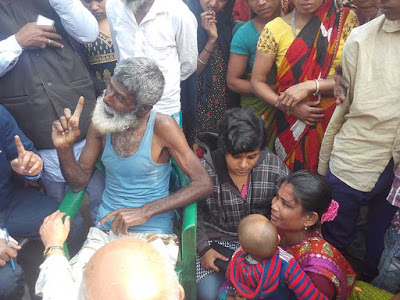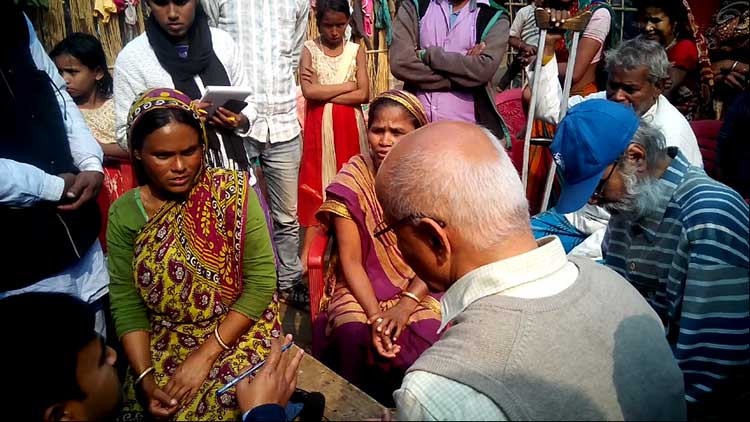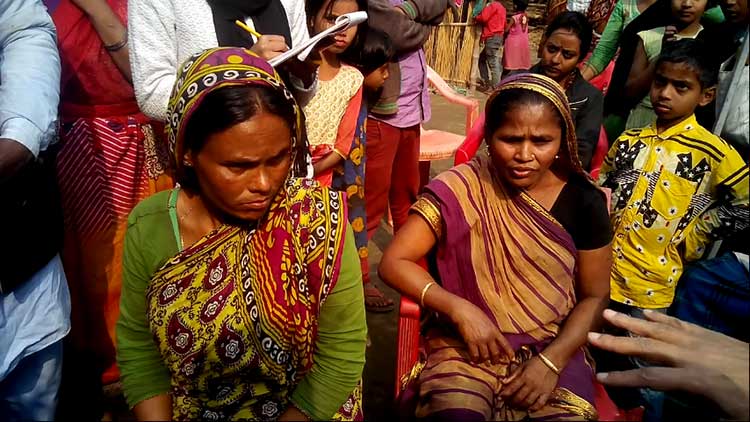Bengal’s Worthy And Unworthy Victims Of Hate Crimes
 |
| Biswajit Roy — February 2, 2018 |
In a way, middle-aged Afrazul Khan of Maldah’s Syedpur, a migrant laborer from West Bengal was lucky to be killed by a Hindutva- induced fanatic in Rajasthan on 6 December last year than his three co-religionists in their early twenties who were battered to death by some Hindu villagers at Chopra in neighboring North Dinajpur six months earlier.
Khan and his family, though at the cost of his life, earned attention of the governments run by rival parties, BJP and Trinamul Congress as well as media at both states. But the families of other victims whose horrible murders closer home had foreshadowed Khan’s killing in the desert state were not so fortunate, despite chilling parallels in the two hate crimes.
There was huge political and media outrage over the premeditated killing of Khan on the day of 25th anniversary of Babri mosque demolition in Rajsamund district of BJP-ruled Rajasthan. The rants of the killer Shambhulal against ‘Love Jihad’ and other purported crimes of Muslims in the murder video, filmed with the help of his nephew and posted to social media revealed the impact of Sangh Parivar’s hate campaigns against Muslims on the monster’s mind. This prompted Vasundhara Raje government to arrest the assassin and announce payment of Rs five lakhs to the victim’s family. Her party and state police portrayed the killer as a lone wolf even after his family divulged his addiction to saffron propaganda videos.
Mamata Banerjee, chief minister of Bengal, the self-declared savior of secularism and Muslims in particular, also sprang up to action. The BJP’s buddy turned bête noire denounced the hate crime as another example of Hindutva terror, sent a high level team comprising ministers and MPs to Khan’s home. She announced payment of Rs three lakhs to his bereaved family, promised educational support to his youngest daughter and job to one of latter’s two elder siblings.
Mamata’s double standard
But Bengal’s prima donna kept mum over the gruesome lynching of Mohammed Nasiruddin, Nasirul Haque and Mohammed Samiruddin on 22 June 2017 at her own backyard. Before Shambhulal and Jharkhand’s cow-protector gangs exhibited the method in their madness, the killers in Mamataland, apparently Hindutva-induced, had filmed their gory act and posted the video clips online. The clipping we accessed showed the Blood-drenched victims praying for their lives only to be pounded with bamboo logs again and again till they breathed their last.
Khan’s killing was a death foretold scene by scene as he too would pray for his life before being bludgeoned to death and charred. The Dinajpur video revealed it was no mob fury but systematic murders at daylight. Local onlookers around watched the public pummeling of the three and their bloody ends but none cared to stop the madness.
Khan’s killing was initially attributed to his ‘affair with a local Hindu woman’ but that did not hold ground following denial by his family and subsequent media and civil society investigations. But the Dinajpur victims were branded as ‘cattle thieves’ by their killers and police alike and it stuck to them despite vehement protests from their families and neighbors.
The Bengal chief minister, who was quick in calling Khan’s murder a hate crime and blaming BJP-RSS for it, did not order any inquiry into that aspect despite increasing communalization of crimes including cattle-lifting in bordering districts like north Dinajpur. The Sangh Parivar’s moves to pit Hindus, mostly Dalits and other scheduled caste refugees from Bangladesh against Muslims.
The Dinajpur killers are still roaming free as Bengal police and ruling party has virtually condoned the triple murders since a case (case no. 505/17 dated 23/6/2017) has been registered under section 304 of the Indian Penal code instead section 302 making the murders unintentional. Consequently, three Hindu youth who had been arrested obtained bail from the court.
Officially, the case is still ‘under investigation’ but police is in no mood to wind up it fast and file the charge-sheet. Instead, the cops have allegedly abused and threatened the victims’ families to arrest them if they persist in their inquiries about fate of the case and seek justice for their dear ones. The law enforcers reportedly have been putting pressure on the families and fellow villagers to delete clippings of the murder video, ostensibly to defang a digital trigger to communal clash. But locals construed it as a move to suppress the crucial proof of the crimes. The families are yet to get the copy of the FIR.
In a letter to the district magistrate, SP and SDO, three bereaved families called it ‘cold blooded and pre-planned murders’, mentioned police abuses and demanded ‘CID or CBI probe.’ But the administration and political leadership has stonewalled their demands. Bengal’s big sis also became selective in her show of compassion. She neither bothered to send a district-level team to visit the bereaved nor offered any monetary help to the visibly impoverished families.

Caravan of Love
This shocking contrast in Mamata government’s dealing with the victims of two hate crimes has come to fore during a recent visit to Khan and other three victims’ villages by a civil society team led by Harsh Mander and John Dayal who have launched a Karwan-e-Mohabwat (Caravan of Love) campaign. They have been meeting families of victims of group and individual hate crimes across the country to express solidarity with them and spread public awareness about hate crimes.
The team members also met family of Kartik Ghosh, the elderly victim of Basirhat communal riot in July last year, at their Basirhat home. This correspondent was part of the team that visited Khan’s family at Syedpur in Maldah’s Kaliachak and another migrant youth Sakir Khan of Swarupganj in Chanchol block who died mysteriously in Rajasthan’s capital, Jaipur . The caravan reached the homes of three lynched men under Islampur and Chopra police station at the last leg of its Bengal tour on 25-26 January this year.

The slain boys
Like many jobless and low-paid villagers of Bengal, these youths belonged to families of migrant labors and themselves worked as construction workers in other states including Delhi. Being residents of three villages closer by, these school drop-outs were close friends and did sundry menial jobs together around the area to eke out a living. All three were married and young fathers. They stayed back home after being egged on by their families, mainly to look after their toddlers and newborns.
Samiruddin of Kandarpar village, eldest among the three deceased was little better placed among the friends. He occasionally employed others as he started manufacturing concrete rings for sanitary pits in the villages. His cousin Abdul Gafur, a junior Imam at Chopra mosque, said deceased Samiruddin was planning to buy a ToTo, a battery-driven auto rickshaw and had taken loan of Rs 40000 for it.
The trap
According to the victims’ families, all three were at their home enjoying special Iftar in the evening of auspicious 27th day of Ramzan that heralded the forthcoming Id festival. The wives of all three recalled that their husbands received repeated calls on their cell-phones asking them to come to a nearby place to discuss an urgent job contract. All left home on their motorcycles assuring to come back early but never returned. Next morning their families learnt either from locals or police that all three had gone to Durgapur, a Hindu-dominated village, few kilometers away under Chopra police station.
“We were told that our boys had been caught while trying to steal cattle from a local household and beaten to death by an enraged mob which had been looking for culprits for rampant cattle lifting. Police brought back the bodies and sent for post mortem. We don’t know whether the rules for autopsy were properly maintained as we were under for pressure for immediate burial.
We told police that the murders were planned as our boys had been called out and trapped. Have you ever heard that cattle thieves visit their target’s home riding motor cycles,” Md. Ashin, the elderly father of slain Md. Nasiruddin at village Dhologachh, asked.
“But police misbehaved with us and refused to listen to our part. They came to conclusion about our children’s crime before investigation. They called us father or wives of Goru Chors heaping ignominy on our families,” the tearful old man added. Deceased Nasirul’s mother Masida Begum at Kutipara village concurred: “Police threatened to lock up us when we visited police station asking for the justice for our children.’’
Both complained that police received bribes from the accused to water down the case. While local Trinamul MLA Hamidul Islam asked locals not to raise a hue and cry to avoid communal clash, the ruling party’s panchayat apparatchiks did not bother to visit them or offer any succor to the landless wage-labor families.
Chopra witnessed communal clash in 2016 like many others areas across Bengal. But none of the affected families or their neighbors vented any ire against Hindus per se while mentioning that the killers from Durgapur were ‘refugees’ from Bangladesh. “They are fearsome and aggressive even to other Hindus and we hardly ventured into their area. What they have done to our boys was unforgivable. But we do not blame all the Hindus here,” Md. Ashin said.
Local boys and men like Jafar Ali, Jishan Rajjak, Saheb Khan and Kashim Ali—mostly seasonal migrant laborers, said that the murder video had gone viral on the day of the lynching itself and they received clippings from various Facebook and Whatsapp groups. “Police claimed it was not related to our case and wanted us to delete it immediately. But we have identified the victims as our own in the murder video. Why they are trying to hush up,” Ali asked.
Hindu women’s honor violated?
Villagers here do not remember circulation of such lynching video earlier. If the filming of the lynching bore the signature of Hindutva campaign, a ‘rumor’ of a Hindu women’s honor being violated by the slain youths pointed to the now familiar pattern of using social media to demonize Muslims and incite hate crimes against them. Md Ashin pointed that his son’s genital was smashed. However, no media reports had mentioned those tales-tell signs of hate crime.
Gafur, Samiruddin’s cousin said he heard it from one Hasrat, a resident of nearby Jhabartala and ‘an accomplice of the three in stealing cycles’. “Hasrat told me that the three had lured away a Hindu girl from Durgapur to Islampur( sub-divisional town) and raped her. Her family and other villagers came to know about it and wanted to avenge it. They asked the girl to set a trap by inviting the boys to her home while pretending to be alone. My brother and his friends landed in the snare only to be killed mercilessly. Some Durgapur people also linked the killings to a Hindu girl’s dishonor. ” He also said Samir was arrested recently in connection to cycle-stealing case.
Samir’s wife Husnara protested to what Gafur said. “I refused to believe it. My husband was not that type. This Hasrat is a shady character and it was he who had called my husband on that fateful evening. My husband had Rs 40000 with him which was looted. ” she said. Local TMC panchayat member Md. Sarifuddin too denied any knowledge of Hindu women’s dishonor as the motive for the lynching. “It was a planned murder and police sitting tight on the case even after eight months,” he said. Gafur later buckled saying he too ‘did not believe Hasrat’.
It is the police’s job to ascertain the true motive behind the murders and unearth the truth if others are only speaking half truths as veteran scribe Dayal felt. Nonetheless, the law of land does not condone lynching or planned murder even if it is motivated by revenge for alleged cattle-lifting or sex crime or the both, he pointed out.
But the team’s visit to Chopra police station along with the three bereaved families revealed that police had virtually outsourced it responsibility to village vigilantes and excused their wild justice as a welcome deterrent. A young lady officer on duty spoke informally: “This area is not good. Villagers here don’t leave cattle thieves if public manage to catch them. One of the three boys had been arrested earlier in connection of cycle-lifting earlier. A case has been started under Section 304 as the murders were apparently unintentional.”
However, the officer In-charge, Gautam Roy was taciturn and refused reply to queries that Mander made – why a murder case under section 302 was not instituted even after three persons were killed in a single incident and why police is not responding to the victims’ families. “I can’t answer. You need to meet our SP,” was his standard reply after he apparently spoke to the district top cop. When the team wanted security to visit Durgapur, he declined leaving it to the team whether they would face any trouble there.
Mander told him that he was familiar with official stonewalling tactics and hostility as former district collector (before he resigned from IAS after Gujarat 2002) which he had encountered more since then.
“Nevertheless, I find it unacceptable that Bengal police under a secular government is no different from states under BJP in their treatment of families of victims of hate crimes, disguised or open. The betrayal of governments of political parties that claim to be secular in failing to defend their minorities rankles painfully and erodes the secular promises of India’s constitution,” he commented later.
The politics behind the silence
The Chopra lynching was not an isolated incident. In the early hours of 27 August, 2017, another two youth, Hafizul Sheikh of Dhubri district in Assam and Anwar Hussain of Patlakhawa village of Cooch Behar district were beaten to death by locals near Barohalia village in Jalpaiguri’s Dhupguri area . They were transporting cattle from local cattle market to Tufanganj in Cooch Behar when they were apprehended by a mob and lynched as cattle thieves. Dhupguri is another area which has recently witnessed BJP’s growth electorally. But Mamata government dealt the incident in Chopra way.
As of 31 August, 2017, West Bengal accounted for 55 percent — or five of nine — deaths recorded in bovine-related attacks reported across India, data-analyzing portal IndiaSpend’s database shows. With six deaths recorded since 2010, West Bengal is now on a par with Uttar Pradesh, which recorded as many deaths in 12 incidents of such violence over eight years. In this same period, West Bengal has reported three incidents – all of which reported fatalities.
In their famous treatise on manufacturing public consent by American big media and the military-industrial behemoths, Noam Chomosky and Edward Hermann had coined the categories of ‘worthy and unworthy’ victims of Cold War era. Those fell for cause of the US-led ‘free world’ were considered worthy of public appreciation while those on the other were unworthy of it. It seems Mamata Banerjee and secular politicians of her hue have adopted that binary in dealing with the victims of communal crimes in BJP-ruled states and their own fiefdoms.
The police response only reflected the state government’s politics. Mamata has repeated denied the gravity of increasing communal clashes and violence by cow-protectors in Bengal, which so far has taken toll of approx. 40 deaths since she has assumed office in 2011. Further, religious identity of those murdered in Dinajpur and Jalpaiguri has apparently impelled her government to keep the killings under the wrap. They are handy when happens outside her realm but an embarrassment when occurs inside.
For, lynching of Muslim youths in Bengal under her nose compromises her image as the protector of Muslims who comprise 27 per cent of Bengal population. It provides her a crucial vote-bank against mounting BJP campaign to bag Bengal in 2019 through communal polarization.
It may be pointed out that cattle-lifting and smuggling is common in bordering districts of Bengal and an elaborate chain of organized crime involving Hindu and Muslim police-politicians-criminals operates across the Indo-Bangla border. But recent communalization of the crime and profiling of the murdered youth in that mode is part of the Sangh Parivar campaign that aims at dovetailing north India’s Gau-Rakshak vigilantism with Bengal farmers’ rage against local cattle thieves.
Further, recent riots in Basirhat, Nakasipara and elsewhere in south Bengal has underlined the Sangh Parivar strategy to pit dalit Namashudras and other low-rung Hindus, mostly ‘refugees’ from Bangladesh with bitter memories of religious persecution at the other side of the border against Muslims in a bid to break Mamata’s Matua(a populous Namashudra sect) and Muslim combine.
Hindus and Muslims are almost evenly matched in numbers in North Dinajpur which suffered communal convulsions in Chopra and Raria recently. The lack of justice to victims of the lynching would only make room for hotheads and fundamentalists on the other side of the religious divide. But Mamata seems to be happy to sit tight on the tinder box.
Biswajit Roy is a Calcutta-based retired journalist who had worked with The Telegraph, Times of India, The Statesman as well as Anandabazar Patrika. He served stints in the north-east and north India as well as in his home state, West Bengal. Keen on independent reporting from below, he focuses on human rights issues and grassroots movements of marginal communities as well as struggles against communalism and fundamentalisms of all hues. Roy recently edited a compilation of reports on increasing communal violence in Bengal and politics behind it, published at Kolkata Book fair 2018. Comments are welcome to biswajitr60@gmail.com


